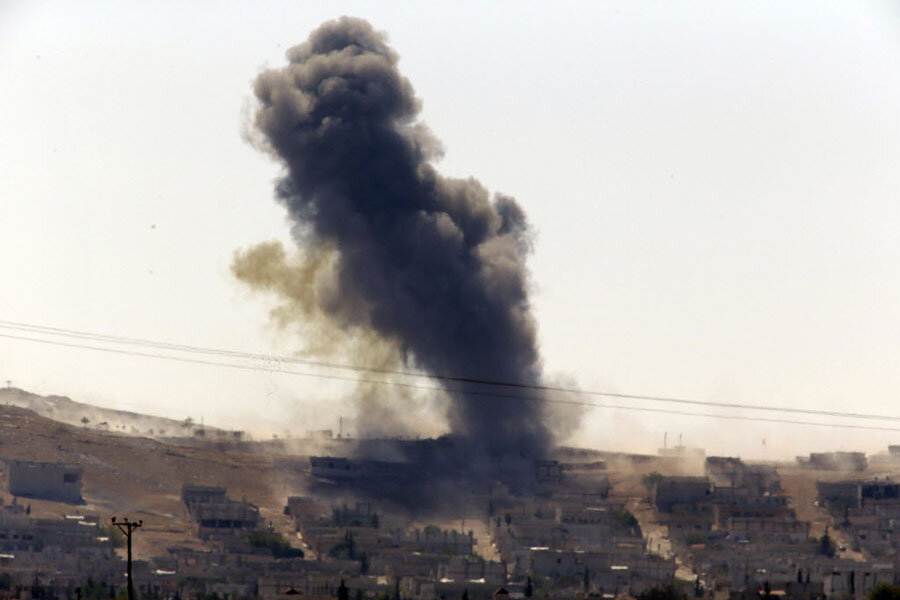Does Islamic State progress in Kobane show limits of Obama's policy?
| Washington
The inability of the US-led coalition fighting the Islamic State to halt the siege of a Syrian Kurdish town abutting the Turkish border is raising new doubts about President Obama’s heavy reliance on airstrikes to defeat the extremist militant group.
A fresh round of airstrikes on IS positions Tuesday appear to have slowed – but not stopped – the advance of IS fighters into Kobane, an agricultural hub in Syria’s Kurdish north and a key border crossing into Turkey.
But whether or not Kobane falls, the larger lesson of the fight will have been that IS will never be defeated with airstrikes, largely because of the way the group fights, some military experts say.
“If we want to win, we have to put boots on the ground, no way around that,” says Christopher Harmer, a Middle East security analyst at the Institute for the Study of War in Washington.
Noting that IS, also known as ISIS or ISIL, is a terrorist insurgency and not a regular army that gathers and trains in large groups, Mr. Harmer says that air power can only be effective against IS fighters when they assemble for a battle like the one raging for control of Kobane.
But by then, he adds, it’s almost too late.
“What the IS fighting strategy means is that we could not really defend Kobane with airstrikes until Kobane was on the verge of collapse,” he says.
With Turkish President Recep Tayyip Erdogan declaring in a visit to Turkey’s southern border Tuesday that the ramped up airstrikes were probably too late, Kobane indeed appeared on the verge of falling into the hands of IS fighters.
That would be a setback for the US that would leave the terrorist group in control of a piece of NATO’s southern doorstep – and which would suggest that IS is still advancing.
Kobane’s fall would also lend new force to critics of Mr. Obama’s strategy for defeating IS, who say that the job cannot be done with US airstrikes alone. Like it or not, they say, the president is going to have to commit at least a small number of US ground troops to the fight.
“There is no way I can see how we’re going to fix the problem in Iraq, in Syria, without American ground troops,” says Sen. Lindsey Graham (R) of South Carolina, who has insisted on the need for a US ground component since Obama laid out his anti-IS strategy in September.
Senator Graham and his colleague, John McCain (R) of Arizona, say that airstrikes won’t work unless accompanied by a US ground presence. The two senators, who have argued for a more robust US military effort in Syria since fighting broke out there more than three years ago, argued in an opinion piece in The Wall Street Journal last month that the US will “need a limited troop presence on the ground” to direct airstrikes, advise local forces, and conduct special forces operations.
The Obama strategy recognizes that airstrikes alone will not defeat IS, but it calls for twinning airstrikes with close work with local forces – not US forces – on the ground. In Iraq, that is supposed to be the Iraqi military, and in Syria the moderate opposition fighters – although senior US military officials concede that it would take years to train and build an effective Syrian partner.
In Kobane, those local ground forces exist in the form of Kurdish militia fighters. But the Kurdish fighters report being woefully outgunned by IS fighters using artillery and other heavy weaponry seized from defeated Syrian government forces.
Syria’s Kurdish militias have faced opposition from a wary Turkish government as they have sought to upgrade their weaponry. And more recently, the US has worried that the more sophisticated arms it could provide would end up in the wrong hands – as happened in Iraq – if the militias were defeated by IS, some military analysts say.
But Harmer says the more the fight against IS results in street combat, like what’s occurring now in Kobane, the more the need for US forces on the ground will become apparent.
“If you have two forces on the ground, like the Syrian Kurdish and IS fighters, in street battles with some civilian population still around, you can’t use airstrikes unless you have somebody on the ground who knows the two sides, can communicate with that pilot at 30,000 feet, and so can call in the strikes with accuracy,” Harmer says.
“We may not like it,” he adds, “but if we really want to defeat these guys, we have to get up close and personal, and punch them in the face.”







